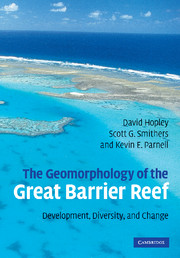Book contents
- Frontmatter
- Contents
- Preface
- Acknowledgements
- 1 Geomorphology and the Great Barrier Reef
- 2 Foundations of the Great Barrier Reef
- 3 Sea level: a primary control of long-term reef growth and geomorphological development
- 4 Oceanography, hydrodynamics, climate, and water quality as influences on reef geomorphological processes
- 5 Spatial analysis of the morphology of the reefs and islands of the Great Barrier Reef
- 6 The non-reefal areas of the continental shelf
- 7 Fringing and nearshore coral reefs
- 8 The mid-shelf reefs of the Great Barrier Reef
- 9 The coral reefs of the outer shelf of the Great Barrier Reef
- 10 Islands of the Great Barrier Reef
- 11 The accumulation of the Holocene veneer to the Great Barrier Reef
- 12 The Holocene evolution of the Great Barrier Reef province
- 13 Geomorphology's contribution to the understanding and resolution of environmental problems of the Great Barrier Reef
- References
- Geographic index
- Subject index
4 - Oceanography, hydrodynamics, climate, and water quality as influences on reef geomorphological processes
Published online by Cambridge University Press: 22 August 2009
- Frontmatter
- Contents
- Preface
- Acknowledgements
- 1 Geomorphology and the Great Barrier Reef
- 2 Foundations of the Great Barrier Reef
- 3 Sea level: a primary control of long-term reef growth and geomorphological development
- 4 Oceanography, hydrodynamics, climate, and water quality as influences on reef geomorphological processes
- 5 Spatial analysis of the morphology of the reefs and islands of the Great Barrier Reef
- 6 The non-reefal areas of the continental shelf
- 7 Fringing and nearshore coral reefs
- 8 The mid-shelf reefs of the Great Barrier Reef
- 9 The coral reefs of the outer shelf of the Great Barrier Reef
- 10 Islands of the Great Barrier Reef
- 11 The accumulation of the Holocene veneer to the Great Barrier Reef
- 12 The Holocene evolution of the Great Barrier Reef province
- 13 Geomorphology's contribution to the understanding and resolution of environmental problems of the Great Barrier Reef
- References
- Geographic index
- Subject index
Summary
Introduction
Reef morphology is the product of contemporary physical, biological, and chemical processes, acting on inherited surfaces and frameworks, but morphodynamic feedback exists whereby simultaneously, reef shape and the configuration of reef complexes significantly affect the way the basic driving forces such as waves, tides, long period oscillations, and freshwater plumes operate. Although descriptions of the hydrodynamics and oceanography of the Great Barrier Reef (GBR) were well established in the literature in the 1970s and early 1980s, particularly with the work of Wolanski and Pickard (Pickard et al., 1977; Wolanski, 1983; Wolanski and Bennett, 1983; Wolanski and Pickard, 1985), there had been little consideration of the physical processes affecting reef geomorphology of the GBR (Parnell, 1988b), except at the individual reef scale (e.g., Davies and West, 1981; Frith, 1983a). In the last two decades there has been considerable research building on the understanding of basic driving forces and processes (excellently summarized by Wolanski (1994), in the book Physical Oceanographic Processes of the Great Barrier Reef), particularly with respect to the links between physical and biological processes (Wolanski, 2001). Another significant theme, driven to a large extent by management agencies, has been the effect of terrestrial runoff on reefs (Furnas, 2003), although most consideration has been given to coral assemblages rather than to reefs over larger time and space scales. However, biological researchers have now recognized that small-scale experiments provide limited insights into phenomena that operate at larger space and longer timescales (Hughes et al., 1999).
- Type
- Chapter
- Information
- The Geomorphology of the Great Barrier ReefDevelopment, Diversity and Change, pp. 92 - 137Publisher: Cambridge University PressPrint publication year: 2007



